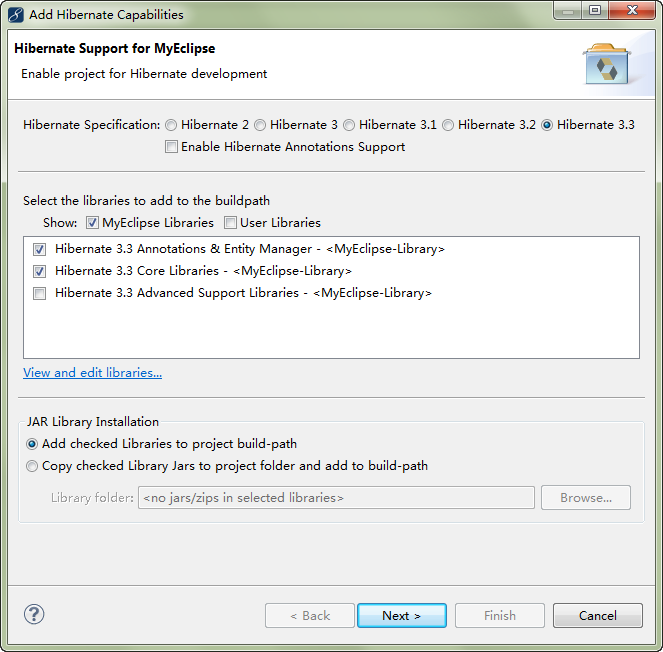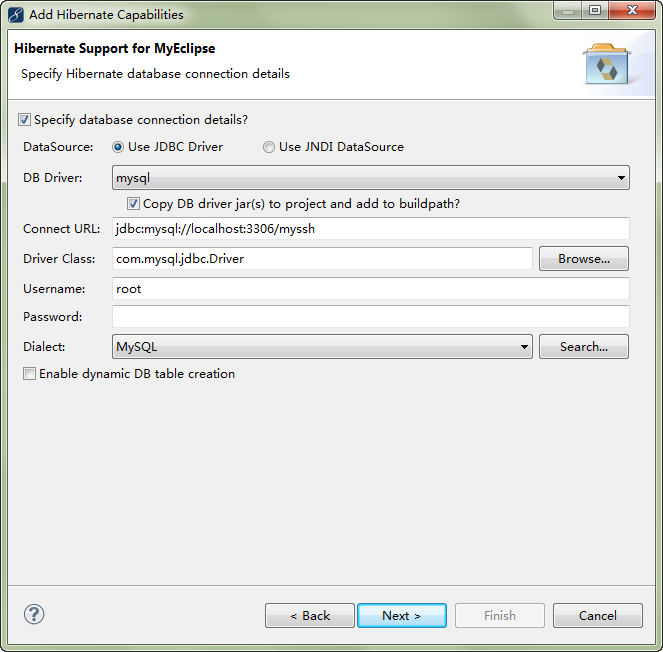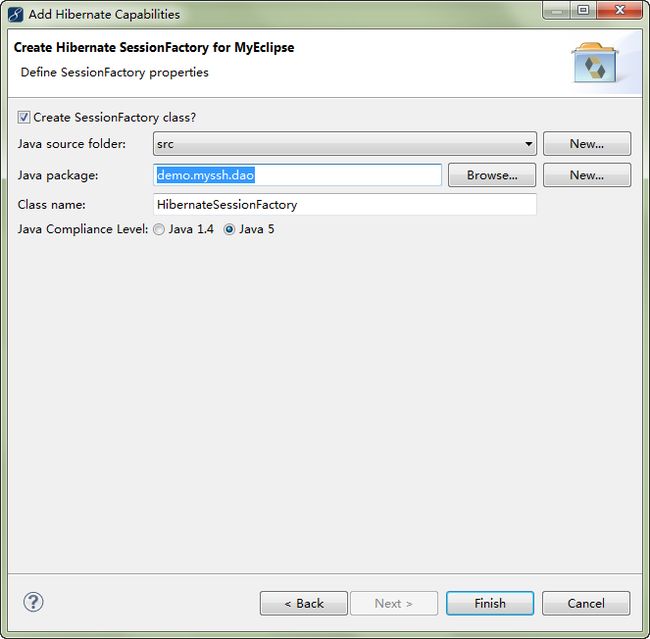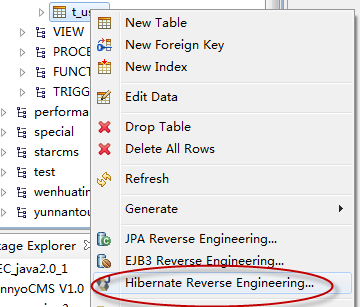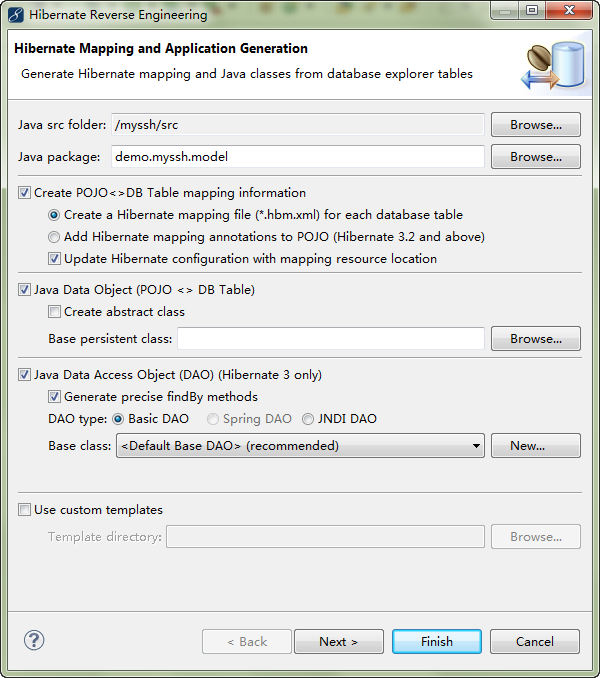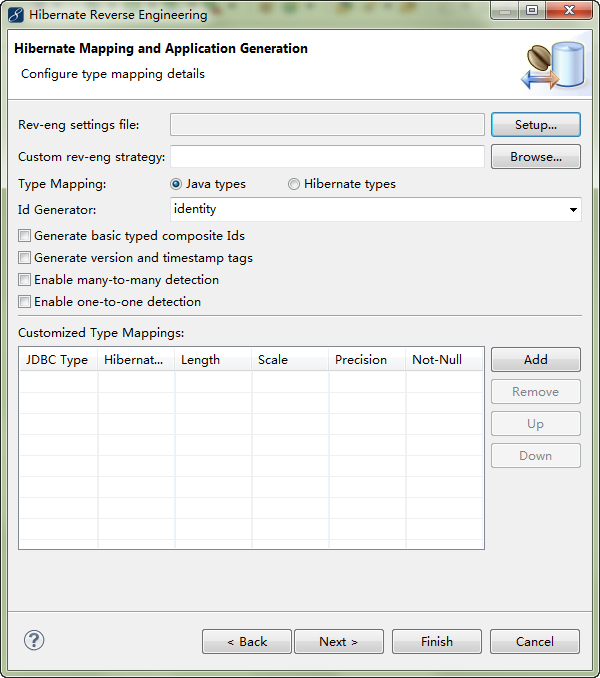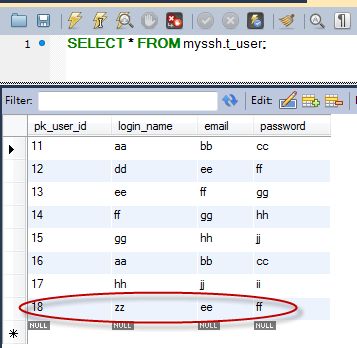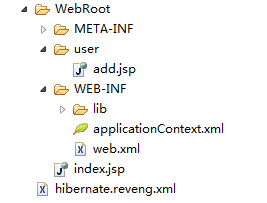SSH框架学习(五、在struts和spring基础上加入hibernate)
Hibernate有很机械的pojo类和hbm文件要写,这部分用myeclipse来做,能省不少事情,终于又感觉到myeclipse的好处了。
1、先在mysql里面建个表
CREATE TABLE `t_user` ( `pk_user_id` bigint(20) NOT NULL AUTO_INCREMENT, `login_name` varchar(45) DEFAULT NULL, `email` varchar(45) DEFAULT NULL, `password` varchar(45) DEFAULT NULL, PRIMARY KEY (`pk_user_id`) ) ENGINE=InnoDB DEFAULT CHARSET=utf8;
2、让myeclipse连接到数据库,还会帮我们自动生成hibernate的配置文件,和一个sessionFactory类。
3、用myeclipse生成实体类和映射配置文件,在myeclipse的db browser里面,打开数据库,选中表。
最后会生成这样一堆文件
整理一下,我是这么放的
4、把myeclipse添加的lib引用去掉,换成hibernate4。
就是这两个hibernate 3.3的,去掉。
hibernate最新版是4.1.8,下载地址http://sourceforge.net/projects/hibernate/files/hibernate4/
解压开后,在lib目录下有个叫required的目录,下面放的是最基本的包,这个我喜欢,比struts和spring做的好。
引入这些包就好了
此外还需要mysql的连接包,最新版本5.1.22,下载地址:http://www.mysql.com/downloads/connector/j/
5、现在开始来修改,从web页面开始
在网站根目录下,增加一个user目录,下面添加一个add.jsp文件。
<%@ page language="java" import="java.util.*" pageEncoding="UTF-8"%>
<%@ taglib prefix="s" uri="/struts-tags" %>
<%
String path = request.getContextPath();
String basePath = request.getScheme()+"://"+request.getServerName()+":"+request.getServerPort()+path+"/";
%>
<!DOCTYPE HTML PUBLIC "-//W3C//DTD HTML 4.01 Transitional//EN">
<html>
<head>
<title>My JSP 'add.jsp' starting page</title>
<meta http-equiv="pragma" content="no-cache">
<meta http-equiv="cache-control" content="no-cache">
</head>
<body>
<form name="form1" method="post" action="user!add.action">
<p>
<label for="loginname">loginname</label>
<input type="text" name="loginname">
</p>
<p>
<label for="email">email</label>
<input type="text" name="email">
</p>
<p>
<label for="password">password</label>
<input type="text" name="password">
</p>
<p>
<input type="submit" name="submit" value="提交">
</p>
</form>
This is my JSP page. <br>
</body>
</html>
这个页面,将内容提交到了UserAction类的add方法,现在来修改UserAction类。
UserAction类里面要添加add方法,和接收页面信息的属性及方法。
package demo.myssh.action;
import com.opensymphony.xwork2.ActionSupport;
import demo.myssh.business.UserService;
import demo.myssh.model.User;
@SuppressWarnings("serial")
public class UserAction extends ActionSupport {
@Override
public String execute() throws Exception {
this.addActionMessage("UserAction working");
// this.addActionMessage("hello world.");
this.addActionMessage(userService.doing());// 修改下,确认注入成功。
return ActionSupport.SUCCESS;
}
// 注入用属性
private UserService userService;
// 注入用的方法
public void setUserService(UserService userService) {
this.userService = userService;
}
public String add() throws Exception {
userService.save(new User(loginname, email, password));
return ActionSupport.SUCCESS;
}
private String loginname;
private String email;
private String password;
public void setLoginname(String loginname) {
this.loginname = loginname;
}
public void setEmail(String email) {
this.email = email;
}
public void setPassword(String password) {
this.password = password;
}
}
这里面,用到了UserService类里面的save方法,继续修改UserService。
package demo.myssh.business;
import demo.myssh.dao.UserDAO;
import demo.myssh.model.User;
public class UserService {
public String doing() {
return "UserService working";
}
private UserDAO userDAO;
public void setUserDAO(UserDAO userDAO) {
this.userDAO = userDAO;
}
public void save(User user) {
userDAO.save(user);
}
}
UserDAO这个类不需要多少修改,只需要把里面日志有关的地方去掉就可以了。因为,我没有引入那个类。大家都喜欢用log4j,打算之后加入log4j。
package demo.myssh.dao;
import java.util.List;
import org.hibernate.LockMode;
import org.hibernate.Query;
import org.hibernate.criterion.Example;
import demo.myssh.model.User;
public class UserDAO extends BaseHibernateDAO {
// property constants
public static final String LOGIN_NAME = "loginName";
public static final String EMAIL = "email";
public static final String PASSWORD = "password";
public void save(User transientInstance) {
try {
getSession().save(transientInstance);
} catch (RuntimeException re) {
throw re;
}
}
public void delete(User persistentInstance) {
try {
getSession().delete(persistentInstance);
} catch (RuntimeException re) {
throw re;
}
}
public User findById(java.lang.Long id) {
try {
User instance = (User) getSession().get("User", id);
return instance;
} catch (RuntimeException re) {
throw re;
}
}
public List findByExample(User instance) {
try {
List results = getSession().createCriteria("User")
.add(Example.create(instance)).list();
return results;
} catch (RuntimeException re) {
throw re;
}
}
public List findByProperty(String propertyName, Object value) {
try {
String queryString = "from User as model where model."
+ propertyName + "= ?";
Query queryObject = getSession().createQuery(queryString);
queryObject.setParameter(0, value);
return queryObject.list();
} catch (RuntimeException re) {
throw re;
}
}
public List findByLoginName(Object loginName) {
return findByProperty(LOGIN_NAME, loginName);
}
public List findByEmail(Object email) {
return findByProperty(EMAIL, email);
}
public List findByPassword(Object password) {
return findByProperty(PASSWORD, password);
}
public List findAll() {
try {
String queryString = "from User";
Query queryObject = getSession().createQuery(queryString);
return queryObject.list();
} catch (RuntimeException re) {
throw re;
}
}
public User merge(User detachedInstance) {
try {
User result = (User) getSession().merge(detachedInstance);
return result;
} catch (RuntimeException re) {
throw re;
}
}
public void attachDirty(User instance) {
try {
getSession().saveOrUpdate(instance);
} catch (RuntimeException re) {
throw re;
}
}
public void attachClean(User instance) {
try {
getSession().lock(instance, LockMode.NONE);
} catch (RuntimeException re) {
throw re;
}
}
}
BaseHibernateDAO 不用改,沿用
package demo.myssh.dao;
import org.hibernate.Session;
public class BaseHibernateDAO implements IBaseHibernateDAO {
public Session getSession() {
return HibernateSessionFactory.getSession();
}
}
IBaseHibernateDAO 不用改,沿用
package demo.myssh.dao;
import org.hibernate.Session;
public interface IBaseHibernateDAO {
public Session getSession();
}
HibernateSessionFactory这个类要修改,因为hibernate 4 创建session的方法变了。
package demo.myssh.dao;
import org.hibernate.HibernateException;
import org.hibernate.Session;
import org.hibernate.cfg.Configuration;
import org.hibernate.service.ServiceRegistry;
import org.hibernate.service.ServiceRegistryBuilder;
public class HibernateSessionFactory {
private static String CONFIG_FILE_LOCATION = "/hibernate.cfg.xml";
private static final ThreadLocal<Session> threadLocal = new ThreadLocal<Session>();
private static Configuration configuration = new Configuration();
private static org.hibernate.SessionFactory sessionFactory;
private static String configFile = CONFIG_FILE_LOCATION;
private static ServiceRegistry serviceRegistry;
static {
try {
//hibernate 3 的方法
// configuration.configure(configFile);
// sessionFactory = configuration.buildSessionFactory();
//hibernate 4 的方法
serviceRegistry = new ServiceRegistryBuilder().applySettings(
configuration.configure().getProperties())
.buildServiceRegistry();
sessionFactory = configuration.buildSessionFactory(serviceRegistry);
} catch (HibernateException e) {
System.err.println("%%%% Error Creating SessionFactory %%%%");
e.printStackTrace();
}
}
private HibernateSessionFactory() {
}
public static Session getSession() throws HibernateException {
Session session = (Session) threadLocal.get();
if (session == null || !session.isOpen()) {
if (sessionFactory == null) {
rebuildSessionFactory();
}
session = (sessionFactory != null) ? sessionFactory.openSession()
: null;
threadLocal.set(session);
}
return session;
}
public static void rebuildSessionFactory() {
try {
// configuration.configure(configFile);
// sessionFactory = configuration.buildSessionFactory();
serviceRegistry = new ServiceRegistryBuilder().applySettings(
configuration.configure().getProperties())
.buildServiceRegistry();
sessionFactory = configuration.buildSessionFactory(serviceRegistry);
} catch (HibernateException e) {
System.err.println("%%%% Error Creating SessionFactory %%%%");
e.printStackTrace();
}
}
public static void closeSession() throws HibernateException {
Session session = (Session) threadLocal.get();
threadLocal.set(null);
if (session != null) {
session.close();
}
}
public static org.hibernate.SessionFactory getSessionFactory() {
return sessionFactory;
}
public static void setConfigFile(String configFile) {
HibernateSessionFactory.configFile = configFile;
sessionFactory = null;
}
public static Configuration getConfiguration() {
return configuration;
}
}
User实体类不用改,不过还是贴出来吧。
package demo.myssh.model;
public class User implements java.io.Serializable {
private static final long serialVersionUID = -8290754809696899650L;
private Long userID;
private String loginName;
private String email;
private String password;
/** default constructor */
public User() {
}
/** full constructor */
public User(String loginName, String email, String password) {
this.loginName = loginName;
this.email = email;
this.password = password;
}
// Property accessors
public Long getUserID() {
return this.userID;
}
public void setUserID(Long userID) {
this.userID = userID;
}
public String getLoginName() {
return this.loginName;
}
public void setLoginName(String loginName) {
this.loginName = loginName;
}
public String getEmail() {
return this.email;
}
public void setEmail(String email) {
this.email = email;
}
public String getPassword() {
return this.password;
}
public void setPassword(String password) {
this.password = password;
}
}
还有映射文件,记得添加下package,让hibernate能找到实体类
<?xml version="1.0" encoding="utf-8"?>
<!DOCTYPE hibernate-mapping PUBLIC
"-//Hibernate/Hibernate Mapping DTD 3.0//EN"
"http://www.hibernate.org/dtd/hibernate-mapping-3.0.dtd">
<hibernate-mapping package="demo.myssh.model">
<class name="User" table="t_user" catalog="myssh">
<id name="userID" type="java.lang.Long">
<column name="pk_user_id" />
<generator class="identity"></generator>
</id>
<property name="loginName" type="java.lang.String">
<column name="login_name" length="45"/>
</property>
<property name="email" type="java.lang.String">
<column name="email" length="45"/>
</property>
<property name="password" type="java.lang.String">
<column name="password" length="45"/>
</property>
</class>
</hibernate-mapping>
然后是hibernate的配置文件,
<?xml version='1.0' encoding='utf-8'?>
<!DOCTYPE hibernate-configuration PUBLIC
"-//Hibernate/Hibernate Configuration DTD//EN"
"http://www.hibernate.org/dtd/hibernate-configuration-3.0.dtd">
<hibernate-configuration>
<session-factory>
<!-- properties -->
<property name="dialect">org.hibernate.dialect.MySQL5Dialect</property>
<property name="connection.driver_class">com.mysql.jdbc.Driver</property>
<property name="connection.url">jdbc:mysql://localhost:3306/myssh</property>
<property name="connection.username">root</property>
<property name="connection.password"></property>
<property name="connection.autocommit">true</property>
<!-- mapping files -->
<mapping resource="demo/myssh/model/User.hbm.xml" />
</session-factory>
</hibernate-configuration>
这里注意,要添加autocommit属性,因为是用的myeclipse提供的sessionFactory。mapping路径也不要忘了。
最后,修改spring的配置文件applicationContext.xml,提供注入
<?xml version="1.0" encoding="UTF-8"?> <beans xmlns="http://www.springframework.org/schema/beans" xmlns:xsi="http://www.w3.org/2001/XMLSchema-instance" xmlns:p="http://www.springframework.org/schema/p" xmlns:util="http://www.springframework.org/schema/util" xsi:schemaLocation="http://www.springframework.org/schema/beans http://www.springframework.org/schema/beans/spring-beans-3.0.xsd http://www.springframework.org/schema/util http://www.springframework.org/schema/util/spring-util-3.0.xsd"> <bean id="userAction" class="demo.myssh.action.UserAction"> <property name="userService" ref="userService" /> </bean> <bean id="userService" class="demo.myssh.business.UserService"> <property name="userDAO" ref="userDAO"></property> </bean> <bean id="userDAO" class="demo.myssh.dao.UserDAO"> </bean> </beans>
运行访问:http://localhost:8080/user/add.jsp
提交以后,又转回index.jsp,查看数据库
大功告成,最基本简单的ssh框架搭建终于完成。
程序结构再贴下

